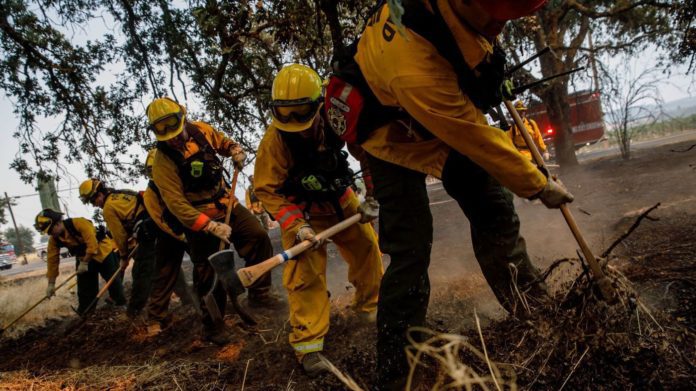

Crews battle two new Northern California wildfires, as the deadly Carr and Ferguson fires continue to burn
Firefighters continued to gain containment Wednesday on more than a dozen wildfires raging across the state, despite challenges posed by hot, dry weather and harsh terrain, authorities said.
A new fire ignited Tuesday afternoon in northern Mendocino County, about nine miles east of Covelo. The Eel fire, as it is being called, was uncontained after burning 865 acres as of Wednesday morning, according to Cal Fire.
The fire is traveling through quick-burning grass and oak in a rural area of rolling hills that can become steep and difficult to access, Cal Fire deputy chief Scott McLean said.
“It’s going to keep growing, hopefully not very much more, but we’ll find out,” McLean said Wednesday morning.
The Eel is the latest of 16 large fires burning throughout the state, according to Cal Fire. Another blaze that ignited Tuesday in Mono County north of Mammoth Lake, called the Owens fire, was 312 acres and also uncontained as of Wednesday morning, according to authorities.
The largest of the blazes is the Carr fire, which as of Wednesday morning had burned 115,538 acres and was 35% contained.
Forecasters say weather will finally return to normal, or close to it, by this weekend, when temperatures will reach the high 90s and humidity will hover around 20%, said Roy Skinner, a spokesman for the California Department of Forestry and Fire Protection.
“Any break in the weather is appreciated — we’re at 35% containment,” he said. “However, we don’t want people to be complacent, or on edge. But the fact is, this fire was started by just one little spark off a vehicle.”
Still, as a low-pressure system approaches from the west, the area could see shifting winds and gusts up 30 miles per hour, said National Weather Service meteorologist Tom Dang.
“This fire has a very unique personality,” said Jason Shanley, a spokesman for the Carr fire. It’s been active at night, while a stubborn inversion layer has kept smoke low to the ground and hindered air support during the day. Conditions also spawned a fire tornado that ripped through parts of Redding. “Every day there’s a new challenge.”
The fire is now mostly burning on its western flank. On the eastern end, more and more of the 38,000 fire evacuees have been allowed to return to their homes — or what is left of them — in and around Redding.
The Carr fire has claimed six lives so far — those of a Redding fire inspector, a private bulldozer contractor and four civilians. It has also destroyed 1,465 structures, becoming the sixth most destructive wildfire in recorded California history.
“Steep terrain, erratic winds, and previously unburned fuels” on the western edge are challenging crews and increasing potential for spot fires, according to a Cal Fire incident report.
Containment is also increasing on the two fires in southern Mendocino County: As of Wednesday morning the Ranch fire was 15% contained after burning 59,014 acres, while the River fire had spread across 31,898 acres and was 38% contained.
“Low humidity, heat and wind will continue to challenge firefighters throughout the day” Wednesday, according to a Cal Fire incident report. Firefighters hope to fully contain both blazes by Aug. 7, according to the report. The low-pressure system will have a similar effect on the weather around these fires and on the Carr fire, Dang said.
Fire officials anticipate that the Ferguson fire near Yosemite National Park will intensify and spread farther into the central Sierra Nevada mountain range, a change in behavior caused largely by the shifting weather patterns expected in the next few days. As of Wednesday, the fire had scorched 62,883 acres.
For the past several days, a high-pressure system has remained over the region. This has created an inversion, which acts like the lid on a pot of boiling water, keeping smoke from rising. As that pressure system lifts, and the inversion disappears, officials anticipate the fire will be fed fresh air and intensify.
Now in its 20th day, the Ferguson fire still threatens to ignite a massive number of dead trees that have been killed off by five years of drought and a bark beetle infestation.
“This fire has amazed me in its ability to do things I’ve never seen before,” fire behavior analyst Robert Scott, with California Interagency Incident Management Team 4, told a large group of firefighters gathered for the daily morning briefing Wednesday. “Be extremely careful down there.”
Safety remains a concern for firefighters. Two have died battling the fire, while another nine firefighters have been injured. Between Oakhurst and Ahwahnee, smoke hangs in the air, and posterboards strapped to road signs and mailboxes along State Route 49 have messages of support for firefighters, with many reading, “Stay safe!”
The features that make the region appealing to tourists and nature lovers — large canyons, tall ridgetops and plunging cliffs — have made the fire more than challenging for firefighters, by creating unpredictable microclimates.
“Unless you’re out there on the ground, feeling the wind and listening to the needles crack underneath your feet,” Scott said, “you can’t give a really precise prediction of what the fire is going to do.”
Source: The Los Angeles Times





